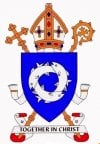Blog
Page 2
The North Pole Mission
9 Jun 2018

A bookshop is an unlikely relic of our Catholic past, but the present Shetland Times Bookshop in Commercial Street, Lerwick, has a long history. In the 1860s it was functioning as the Zetland Hotel and was owned by the O'Brien brothers from Ireland. It was probably here that the first Mass since the Reformation was said on 30th September 1860.
In 1560 Catholicism had been proscribed in Scotland and many of the old churches destroyed. By the nineteenth century Scotland was seen as mission territory and was administered by three Vicars Apostolic appointed by the Holy See. Shetland formed part of the Northern District, centred then on Presholme in Moray, but the Northern Isles were always going to be seen as peripheral to the missionary needs of this huge territory.
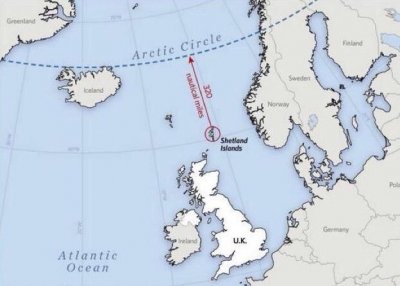
What if you think of Shetland in terms of sea-lanes instead of roads? It was this new perspective which saw Shetland being withdrawn from the Northern District in 1860 and assigned to the Apostolic Prefecture of the North Pole. For nine years Shetland was part of a trans-national ecclesiastical territory, initially centred on Alta in northern Norway, which included Iceland (1857), the Faroe Islands (1857-8), Orkney, Shetland and Caithness (1860-1) and Tromso (1862), and which had aspirations to spread around the Arctic rim from Scandinavia to Greenland, culminating in a mission to the Eskimos of North America.
The first Mass in Lerwick was said by the charismatic Apostolic Prefect of the North Pole Mission, Fr Stefan Djunkowsky (a Russian nobleman from St Petersburg). Djunkowsky did not work long in Shetland, in fact within little more than a year he had left the North Pole Mission altogether. In the short time available to him Djunkowsky had managed to establish a Catholic chapel dedicated to St Anne in the cellar of the building opposite the Shetland Times Bookshop, now occupied by Faerdie-maet.
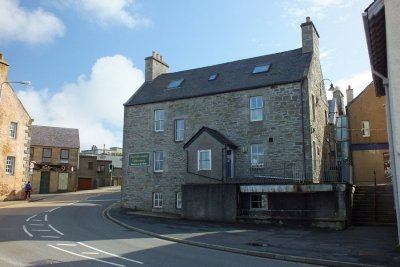
The building was owned by Mr Grant, an early convert, and when Fr Djunkowsky summoned Fr Theophilus Verstraeten from the Faroe Islands to take over the Shetland mission, the Grant family invited him to move into the house.
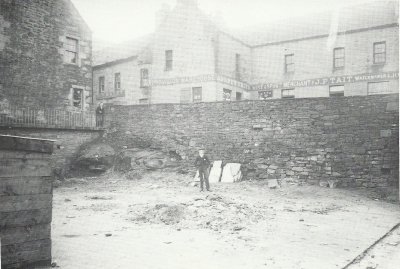
An early photograph of the building shows how much this area of Lerwick has changed. The building which housed St Anne's chapel (on the left of the photograph) was originally a lodberry, jutting into the sea, and the modern Post Office occupies the site of a beach immediately opposite the former Zetland Hotel. The flight of steps between the Faerdie-maet building and the Post Office takes you to what would have been the chapel entrance, opening onto the beach. Djunkowsky described it rather fancifully as of a 'gothic character' and able to accommodate 100 people.
The new priest was not given a very warm welcome. Scotland was celebrating the third centenary of the Protestant Reformation in 1860 and the mission was viewed with suspicion by those who saw it as an example of Papal aggression. The Minister of the United Presbyterian church preached against the mission and an even more zealous opponent set gunpowder charges around the priest's house which, with a midnight explosion "like that of an earthquake", blew out the windows.
Fr Verstraeten eventually won the respect of the people of Lerwick and was much lamented when in 1871, at the age of 39, he died of smallpox contracted from a Belgian fisherman to whom he had administered the last rites. His body was taken back to his native Belgium on the same boat on which he had contracted the fatal disease.

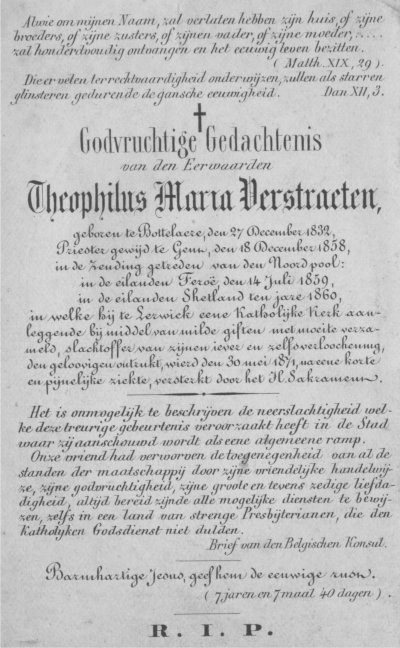
Obit card of Fr Theophilus Verstraeten, (1832-71).
Shetland reached its greatest population during Fr Verstraeten's period as first resident mission priest in Lerwick. The 1861 census showed a resident population of 31,579, nearly fifty percent more than at the present day. Prosperity had come with the fishing business, and with prosperity a cosmopolitan mix of nations.
The Medieval Church in Shetland
7 Jun 2018
In 1469 Shetland was pledged to Scotland as part of a marriage treaty between the royal houses of Denmark and Scotland.
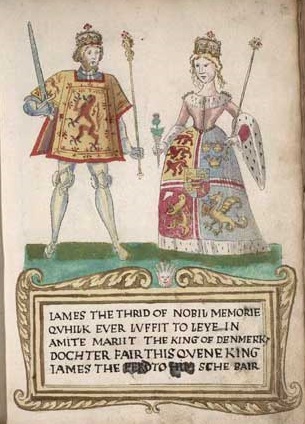
King Christian I was 10,000 florins short of the money due to the King of Scotland as a dowry and Orkney and Shetland were used to plug the deficit. Although the Norwegians tried repeatedly to redeem the Northern Isles, Shetland was henceforth treated as part of the Kingdom of Scotland and in 1472 the administration of the Catholic Church in Shetland shifted from Nidaros (Trondheim) to the new archdiocese of St Andrews.
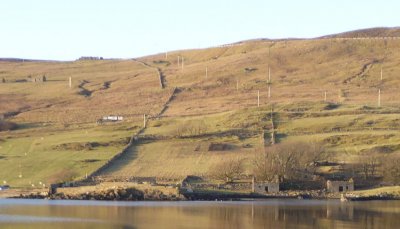
Ladykirk, Weisdale
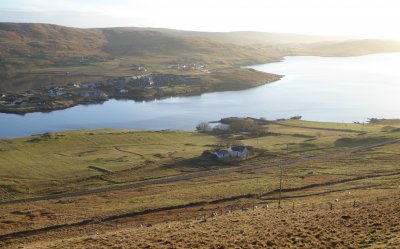
Today the Shetland Islands form a single parish but in the Middle Ages there were about thirty major churches and another ninety or so chapels (not all necessarily functioning at the same time) divided into some fifteen priest's districts. Only one medieval church remains in use, Lunna Kirk in the north mainland, near the ferry port for Whalsay. This had survived as the burial chapel of the Hunter lairds and was made into a Presbyterian kirk in 1753. It is a simple rectangular church, probably constructed in the late middle ages and originally dedicated to St Margaret.
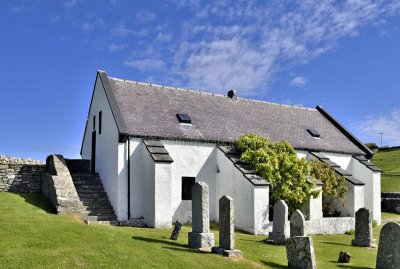
Shetland was never the seat of a bishop but the senior clergyman was the Archdeacon of Shetland who originally resided at St Magnus' Church, Tingwall. Nothing survives now of the medieval church there but in 1985-87, during the excavation of a tithe barn at Kebister, an armorial stone bearing the arms of Henry Phankouth, Archdeacon of Shetland (1502-1529) was discovered and can now be seen in the Lerwick museum.
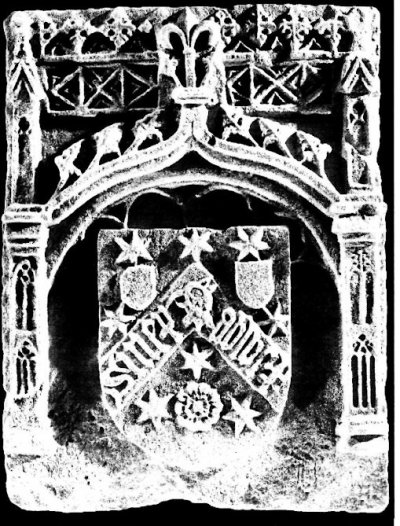
Research by Shetland's archivist, Brian Smith, has revealed something of the background of this stone - and with it a slightly unflattering picture of the late medieval church. Henry Phankouth was the illegitimate son of Andrew Pictoris, a German academic who in 1477, when Henry was seven years old, became Bishop of Orkney. The young Henry Phankouth was sent to study at Cologne University before he was legitimated by his father and ordained to the priesthood. He was only 32 years of age when appointed to this second most senior post in the diocese and remained resident in Orkney throughout the 27 years of his tenure. It was at least a sign of Shetland's continuing ties with continental Europe. The Cistercian monk Robert Reid, who was one of the last Catholic bishops of Orkney (1541-1558), was a Renaissance patron of the arts and while Abbot of Kinloss Abbey in Moray had invited the Italian scholar Giovanni Ferreri to Scotland. Bishop Robert Reid extensively remodelled the Bishop's Palace in Kirkwall, but it is impossible now to say what influence he had on the Catholic church in Shetland, the northern half of his diocese.
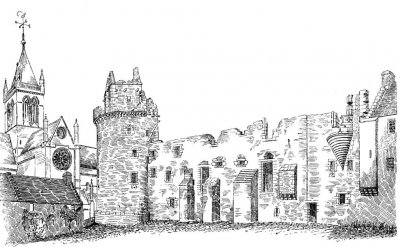
Kirkwall Cathedral and Bishop's Palace in the 19th century
The Scottish Reformation came in 1560. It took time to become established in Shetland and seven years after the official establishment of Presbyterianism the whole of the southern half of Mainland, from Quarff to Sumburgh Head, was served by only one lay-reader. Presbyterianism was not really effective here until 1700 when a committee was appointed by the General Assembly of the Church of Scotland to enquire into the spiritual state of the islands. We do not know when the last Catholic priest stopped ministering to the people, or when the last Mass was said, but there is now a gap of some three hundred years before the history of the Catholic Church in Shetland resumes.
Pat & Mike Loynd's Golden Wedding
6 Mar 2018
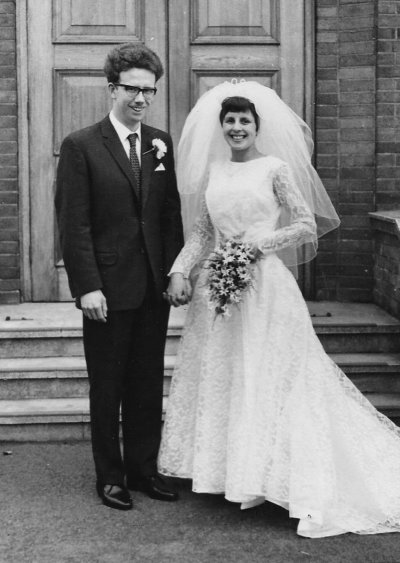
Mike and Pat were born and grew up in the same part of Preston in Lancashire, just around the corner in fact, but they can't remember meeting each other. Although they both worked for their parish in very different ways, Mike in stage management for the Drama group and often as caller for the Bingo in the parish hall, and Pat as Secretary for the Legion of Mary and as Parish Catechist, they only met each other in the sixties.
They started going out together in the late Autumn of 1965. Their first date was at the Locarno Ballroom in Blackpool which was Mike's Annual Works Dance. They were engaged on Pat's twenty-first birthday in April 1966. The next few years were spent climbing, and walking with a group of friends in the Lake District, fishing, taking part in archaeological digs, working and saving for their future home. Mike was working at the Atomic Energy authority as a Radio Chemist working with low level Radio Active material. Pat was working as a Teacher's Assistant in the Kindergarten at Woodlands School, Preston.
Mike got a new job in 1966 as Assistant Keeper of Conservation at Liverpool Museum. Pat was working in Burns & Oates Catholic Bookshop in Liverpool dealing with orders from various schools and colleges in Liverpool and the surrounding area. They bought their first house in Burscough, which was on the railway line to Liverpool, in the summer of 1967.
They were married on 24th February 1968 at the Blessed Sacrament Church, Ribbleton, Preston.
In January 1970 they moved from Burscough to Wetherby in Yorkshire as Mike had got a job as Keeper of Antiquities for Yorkshire and Humberside. Their first two children were born during this time at Harrogate Hospital. Mark in February 1971, and Damian in May 1973. Megon, a Golden Cocker Spaniel puppy came to join the family in Wetherby, but sadly died after being with them for a short time in Leeds.
They left Wetherby to live in Leeds when Mike became Director of the Museum Service for Yorkshire and Humberside as it was nearer the station and also to his place of work. Their two youngest children were born in Leeds, Claire in December 1977 and Michael in November 1979. Two dogs joined the family a Springer Spaniel puppy called Ticker which was her kennel name, and Rags a Border Terrier who had been left on the park in the middle of winter in the area where Mike had his offices. After spending a week with the RSPCA Rags came to live with them. He had a tremendous character and there are enough stories about him to fill a book.
They moved from Leeds to Shetland in 1987 to live at the Grind in Channerwick where they have been for the past thirty years. On Saturday 24th February Mike and Pat celebrated their Golden Wedding with a party at the Carnegie Hall in Sandwick and a very enjoyable evening was had by everyone.
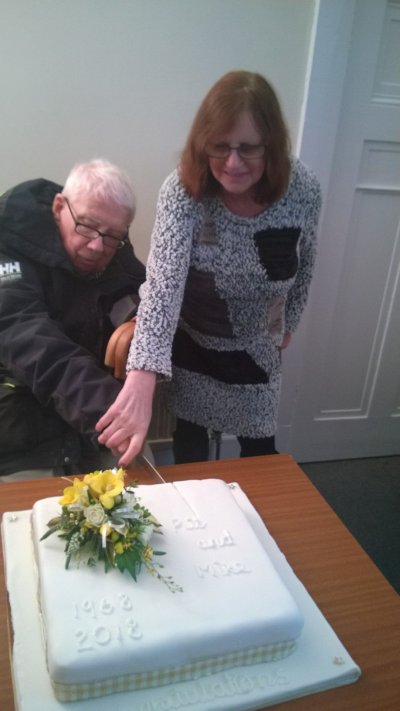
Wilma Laurenson RIP
26 Jan 2018
This tribute was read by John McEvoy at Wilma's funeral in St Margaret's Church, Lerwick, on 25th January 2018.
Thoughtful as ever, Wilma left us detailed instructions for today’s arrangements so, if anyone has any complaints . . . speak to Wilma when the time comes!!
Now then – what to say about our dear friend Wilma.

She was born on the 18th July, 1937 and left us peacefully and in a state of grace on Sunday morning, 21st January 2018.

Wilma at two years of age, Lerwick harbour, July 1939.
Wilma was the only child of Catherine and Robert and was born and lived at 7 Church Lane, Lerwick by the Small Boat Harbour.

Wilma's father, Robert Laurenson (bottom left), was Engineer on the Lerwick RNLI boats in the 1950s and 60s.
In addition to her parents, she lived with her beloved grannie, who seems to have been her protector, co-conspirator and partner in crime, in her early childhood. She attended the Central School in Lerwick along with her life-long friend Willie Halcrow, who is here today. In 1951, the family moved to 5 Cairnfield Road, Lerwick, where Wilma lived for over 60 years.

Wilma in her seventies with Willie Halcrow (left) and Fr Anil Gonsalves.
Wilma was employed in the retail trade initially, in D&G Kay’s the drapers for 29 years and then, in the Garrett children’s clothes shop for a further 18 years, before retiring. She made many close friends and colleagues during this time, including the late Isobel and Gordon Smith – with whom Wilma spent many a happy Christmas Day in Breiwick Road.

Wilma never married and without children of her own, she seems to have spent a lot of time babysitting other peoples. You could hardly walk down the Street with Wilma without being stopped by someone for a chat – often people she had looked after as bairns. You could be forgiven for thinking she had baby-sat every child in Lerwick born between 1950 and 1970 but, in truth, it was probably only half of them!
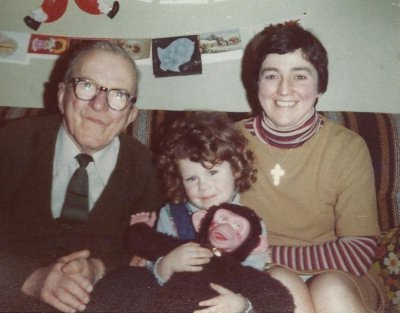
Wilma with her father and a young friend.
Always a devout Christian, having been brought up in the Church of Scotland, Wilma converted to the Catholic faith and was confirmed on 2nd April 1994 by Father Jim Hayes. Wilma helped Father Jim immensely, acting as book-keeper for St Margaret’s and reading his correspondence to him as his eyesight failed.
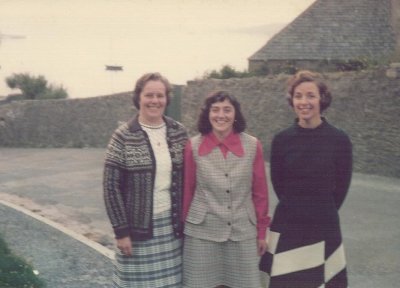
Wilma loved travelling and amongst other places, visited the south coast, Jersey, the Lake District and, of course, her family in Edinburgh. She also ventured much further afield to the Holy Land and made several trips to Canada to spend time with her devoted family in Ontario, including to the christening of her cherished goddaughter Emma. In recent years, along with friends from the parish,Wilma made pilgrimages to Rome, Lourdes and Knock.

Wilma with parishioner Jennifer Keane.
In 2013, Wilma was finding it increasingly hard to manage the stairs at Cairnfield Road and after MUCH discussion, she moved into Flat 13 in King Erik House. Wilma was not always comfortable with change and although we felt she’d made the right choice, we were worried in case she might not settle - but we needn’t have been concerned. Although number 13 might be unlucky for some, it certainly wasn’t for Wilma. She just fell in love with her peerie flat, which she said was ‘Just Perfect!’
The fact that Wilma settled into King Erik House so easily and was so very happy there was entirely due to the dedicated, caring attention of the staff, with whom she had such fun. Wilma certainly loved a fun!
Although Wilma had occasionally faced some difficult and dark days in the past, she came through them all and we had our old pal back once again – caring, impish, fun-loving and goodness itself.
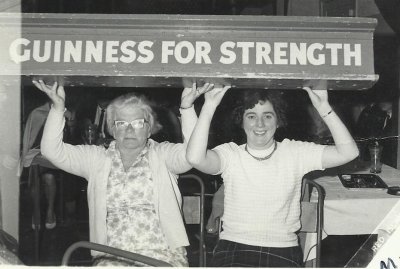
Wilma had a smile to open every heart. We’ll miss your lovely bright smile, Wilma!
God bless.
The Norse Church in Shetland
18 Jan 2018
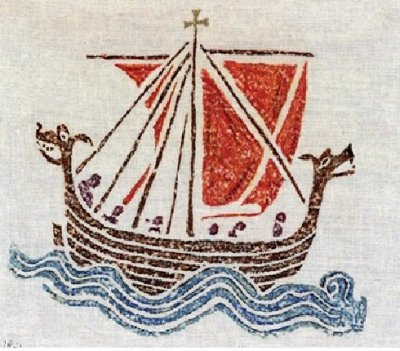
The Viking raids from the beginning of the ninth century probably wiped out the early Celtic church in Shetland since the first Viking settlers were pagan. Christianity was reintroduced after the conversion of King Olaf Tryggvason in 995, and for the next five centuries Shetland formed part of the Norwegian Catholic Church.
![]()
The earliest documented Shetland cleric was 'Svein the priest' on Papa Stour, mentioned in a document of 1299. A little later we hear of priests being appointed to Shetland from Bergen diocese. In 1195 Shetland was withdrawn from the Earldom of Orkney and ruled directly from Norway as a Crown Colony. The church was administered by the Archbishop of Nidaros (Trondheim), assisted by eleven other bishops, including the bishop of Orkney.
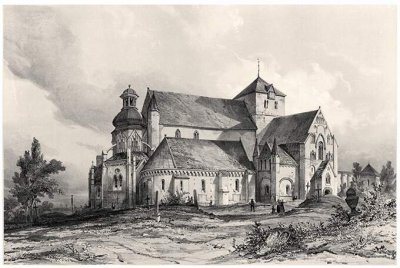
The senior cleric in Shetland was the archdeacon of Tingwall who had his church at a prominent spot at the head of Tingwall Loch, just above the site of the old Norse parliament ('Law Ting Holm') on the promontory jutting into the loch. Legend has it that in the Norse period Shetland had three tower churches, similar to the one still standing on the island of Egilsay in Orkney, built by three Norwegian sisters.

The eldest gifted St Magnus's Church to Tingwall, the youngest gave the church of St Mary to Bigton, and the middle sister gave the church of St Laurence to Burra Isle. All three survived until the end of the 18th century when they were torn down to be replaced by the present Presbyterian kirks. Tingwall had probably been largely rebuilt as a steeple church in the late middle ages since a report on rebuilding Tingwall Kirk dated 1783 noted, "There can be no want of stones, for the steeple wants the dignity of antiquity to become a monument worth preserving. I therefore am humbly of the opinion that it should be used for the new church, especially as it is now the only remains of Popery in the country."
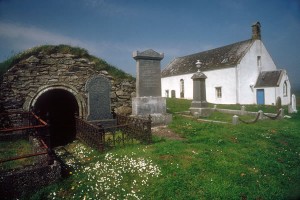
The burial vault (opened in 1952 and now used to preserve the grave slabs from the cemetery) is sometimes described as the only surviving fragment of the old parish church destroyed in 1788, but it dates from the 17th century. Nothing survives above ground of the medieval church.
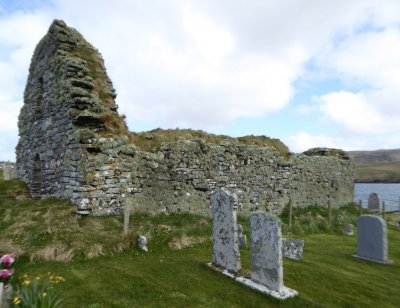
Probably the most imposing relic of the Norse church in Shetland is the ruin of St Olaf's Church at Lund, Unst. It dates from about 1150.
Shetland still belonged to the Earldom of Orkney when the magnificent cathedral dedicated to St Magnus was built in Kirkwall.
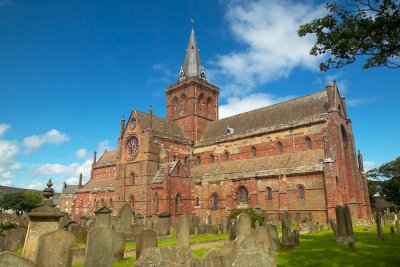
The Norse settlers in Shetland were enthusiastic promoters of the cult of St Magnus and the church built in his honour at Tingwall was constructed from a similar red sandstone shipped from Orkney.
Illustrations:
1. Viking longship from the cover of the book "West over Sea", a Festschrift in honour of Barbara Crawford.
2. Modern icon of St Olaf of Norway.
3. Nineteenth century drawing of Nidaros Cathedral, Trondheim, before restoration.
4. Egilsay Church, Orkney. Site of the martyrdom of St Magnus.
5. 18th century Tingwall Kirk, near the site of St Magnus' Church,Tingwall, showing 17th century burial vault.
6. Ruins of St Olaf's Church, Lund, Unst. 12th century.
7. St Magnus Cathedral, Kirkwall, Orkney. 12th century.
Death in Shetland Waters
10 Jan 2018
Shetland crime writer Marsali Taylor talks about the setting of her latest book, "Death in Shetland Waters".
It was time to give Shetland a break. In just one year of her life, my intrepid sailing heroine, Cass Lynch, had tackled a film star murder, international art thieves, a coven of witches, a missing sailor and a troupe of opera starts ... along with the short stories, I'd committed over twenty murders in this crime-free community.
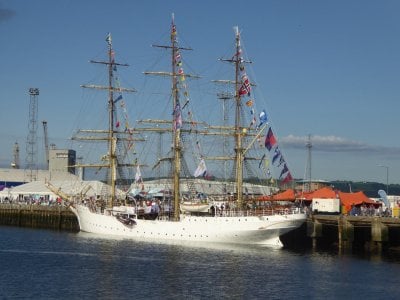
Luckily, Cass had also been doing a college course, to qualify her as a ship's officer - so I gave her a post aboard 'Sorlandet', the smallest of Norway's three Tall Ships. All I had to do was book a berth on a suitable journey for my story: from Kristiansand to Belfast, as part of the 2016 Tall Ships Race.
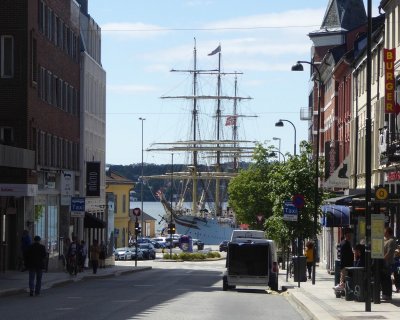
It turned out an unusual voyage. Kristiansand's enlightened social work department had filled the ship with youngsters: immigrant children from Greece, Ethiopia and Iran, Norwegian youngsters in difficult circumstances. Gathered together on the dock, some were clowning to hide apprehension, some were sullenly silent. One face particularly struck me: a girl wearing a Bob Marley fleece jacket, and a hat like a policewoman's, pulled well down over her brow. Her ferocious scowl said 'awkward' to my ex-teacher's eye; a right sea-lawyer there.
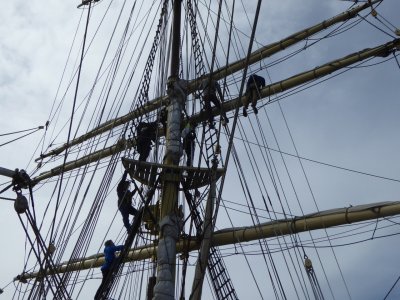
We were split into our watches, and introduced to the ship: hammocks, lockers, toilets and showers forward, navigation aft. Then it was climbing time. The youngsters' eyes lit up. To an adventurous teenager, a tall ship's rigging is a play ground, and they put on their harnesses and headed up the spider's web ratlines with enthusiasm. Me, I have a lousy head for heights, and after one foray along the yards, for pride's sake, I was happy to stay at deck level, taking my turn at lookout and safety watch, and standing under the tiers of sails with my hands on the great ship's wheel, and my eyes on the horizon.
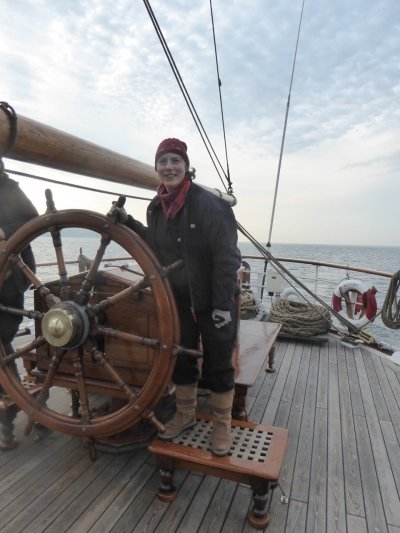
It was a glorious voyage. We passed rock-polished coast with little white lighthouses, capped with red cones, and headed out into the ocean, sailing blindly through the mist. I was on lookout then, with two brothers, and all agreed how good it was to have a real job: with the radar off to let the rest of our watch stow the foremost sails, the safety of all of us really did depend on their sharp eyesight. Further out, the sea became the colour aquamarine was called for, and a pod of dolphins came to surf our bow-wake.
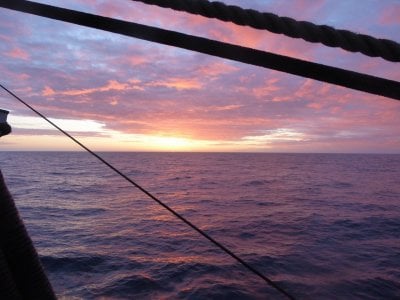
By now the youngsters had stopped being strangers. They'd responded magnificently to shipboard discipline, and even sulky Gabriel appeared on time for watch. Our team was the fastest launching the Man Overboard boat. Intelligent, wayward Sindre translated for the Ethiopians, and Kjell Sigurd learned everyone's tea/coffee preferences, and brought welcome cups of tea to lonely foredeck watchers. As for the girl with the scowl ... Lena was a star in the rig, and enjoyed herself so much that she joined in all the other watches too.
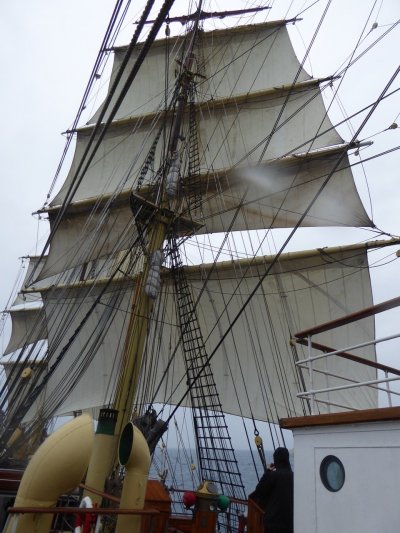
I'm sorry to say I caused mayhem among them. Word got around, of course, that I was an author looking for ideas ... and so I got them. Loads of them; even our dignified Captain Sture sidled up to me, and said,'You know if I was going to dispose of a body on board ...' This is why these murders are probably the nastiest Cass has had to deal with ... committed by an appropriately nasty murderer.
After a magical two days of nothing but sea all around us, we sighted Fair Isle, then Orkney. Not long after that, we were slipping down the west coast of Scotland, with the sea back to polished pewter, and a day after that we sighted Ireland. The arms of Belfast Lough stretched out to enclose us, and we came in under four great cranes like mechanical horses. My proudest moment was helming her in, with Captain Sture himself giving me orders.
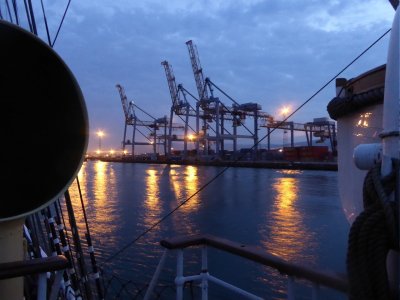
It had been a wonderful voyage. I never use real people in my books, but my watchmates were dead keen to be included, so, with their permission, they're all there, with my best wishes for their future ... and no, none of them is allowed to be either perpetrator or victim of the murderous events Cass has to deal with on board!
Marsali Taylor's latest book "Death in Shetland Waters" was published on 23rd November 2017 and is available from the Shetland Times Bookshop or online from Amazon.
Check out Marsali's website or join her on her Facebook author page.
Celtic Missionaries to Shetland
9 Jan 2018
One of the most tangible links to Shetland's early Christian past is the Monk's Stone found in the churchyard at Papil on Burra Isle.
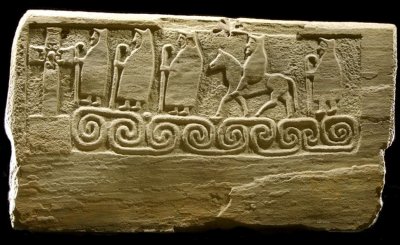
It probably dates from the eighth century (the time of St Bede and the Golden Age of Lindisfarne) and shows five monks, one on horseback. It came from a saint's shrine and may represent the first Celtic missionaries to Shetland. One interpretation is: "Holy men, carrying gospel books (or portable altars) is satchels, with an elderly saint (or bishop - the rider), cam across the sea where they set up the Cross." The stone is now in the Lerwick museum.
Standing at Lerwick harbour it is possible to see the coastguard look-out tower on Ander Hill, Bressay. About a mile to the north of this (to your left, looking from Lerwick) is another important early Christian site at Cullingsburgh. An elaborate stone with a carved cross and the figures of monks (very similar to those found at Papil) was found here and it is of special interest since it shows a mix of Celtic and Scandinavian styles. This was probably carved in the late Ninth Century when the Viking settlement of Shetland had already begun and it has an inscription in Ogham script.
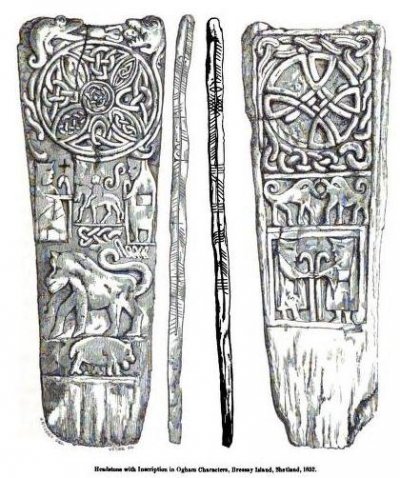
The early Vikings were pagan and most of the early Celtic sites were probably destroyed. It is likely that there had been many small monasteries of Irish or Celtic monks using Shetland as a staging point on missions even further north to the Faroe Islands and Iceland.
Archaeological research in the 1960s identified likely sites for Celtic hermitages at Blue Mull, Unst on the Burrier of West Sandwick, Yell, and on the Kame of Isbister in Northmavine. The many place names including 'Papa' or 'Papil' also comemmorate Christian sites which pre-date the Scandinavian settlement.
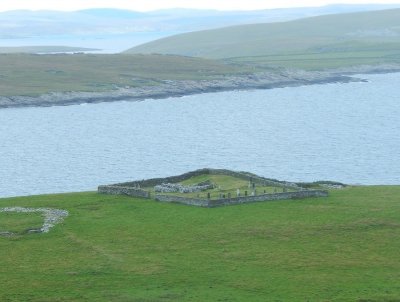
At Cullingsburgh you can still see the ruins of the medieval church of St Mary. The graveyard runs over an earlier prehistoric broch which rises up on the east side. The Bressay stone was found near here. The medieval church may well sit on the earlier Celtic site. Was it a monastery? Who knows, the Bressay stone is carved from schist which is found on Burra Isle but not here. Whoever carved it probably had the Papil stone available before him as a model for the figures of the monks.
It is certainly in a beautiful location beside the sea and is well worth the walk up from the Bressay Ferry. A copy of the Bressay Stone can be seen in the Lerwick Museum.
At this date Shetland was part of the Pictish kingdoms which covered large parts of North East Scotland. Much new information on the 'Papa' sites can now be found on the "Papar Project" website. A link follows.
Early Christian Shetland - St Ninian's Isle
7 Jan 2018

The Mother-Church of Shetland?
Perhaps the earliest Christian site in Shetland is associated with St Ninian, whose feast day falls on 16th September.
St Ninian's Isle is to be found in the South Mainland, about 24 km south of Lerwick and is clearly signposted from the main Lerwick to Sumburgh road. The island is linked to the mainland by a beautiful tombolo of white sand. The chapel site is a little to the right on first reaching the island and is enclosed by a wire fence with interpretative boards within.
There were five seasons of archaeological excavation here from 1955 to 1959, and on 4th July 1958 a local schoolboy working on the dig - Douglas Coutts - uncovered the famous St Ninian's Isle Treasure. Twenty eight silver objects (bowls, brooches and parts of weapons) were found buried within the medieval church under a broken stone slab. The originals are now in the National Museum of Scotland in Edinburgh but replicas are to be seen in Lerwick Museum.
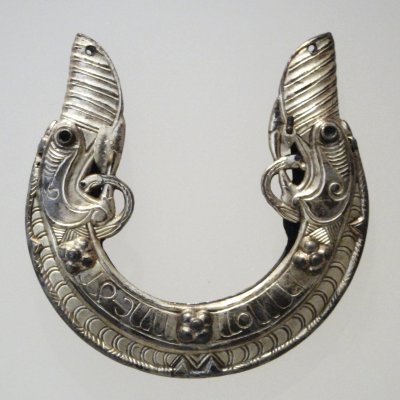
One of the sword-chapes had a Latin inscription,"INNOMINEDS" - abbreviated from "In nomine Dei Summi", "In the name of God the Highest", which shows thatits original owner was a Christian. It was probably buried in an earlier church on the same site about AD 800 and may have been hidden away at the time of the early Viking raids.
There is a strong local tradition that St Ninian's Isle was the Mother Church of Shetland, but there are no pre-Reformation documents relating to it and the chapel fell out of use during the 16th century Reformation. The Revd. John Brand, visiting the site in 1700 wrote, "To the North West of the Ness lyes St Ninian's Isle, very pleasant; wherein there is a Chappel and an Altar in it whereon some superstitious People do burn candles to this day." It is a sign of continuing Catholic devotion on the site into the 18th century.
Pont's map, published in 1654, shows it as 'S Tronon's Yle'. In other areas St Ninian has also been known as St Trinyon.
![]()
St Ninian was apostle to the people in the South West of Scotland in the Fourth Century. There is nothing to link his original missionary journeys to Shetland. Christianity was probably brought to these islands by Celtic monks in the late 7th century.
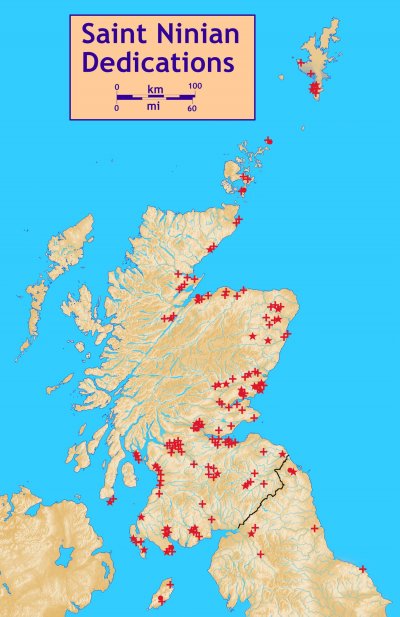
The "Shetland" website has some beautiful photographs of St Ninian's Isle and suggestions for a 6 km circular walk around the island.



